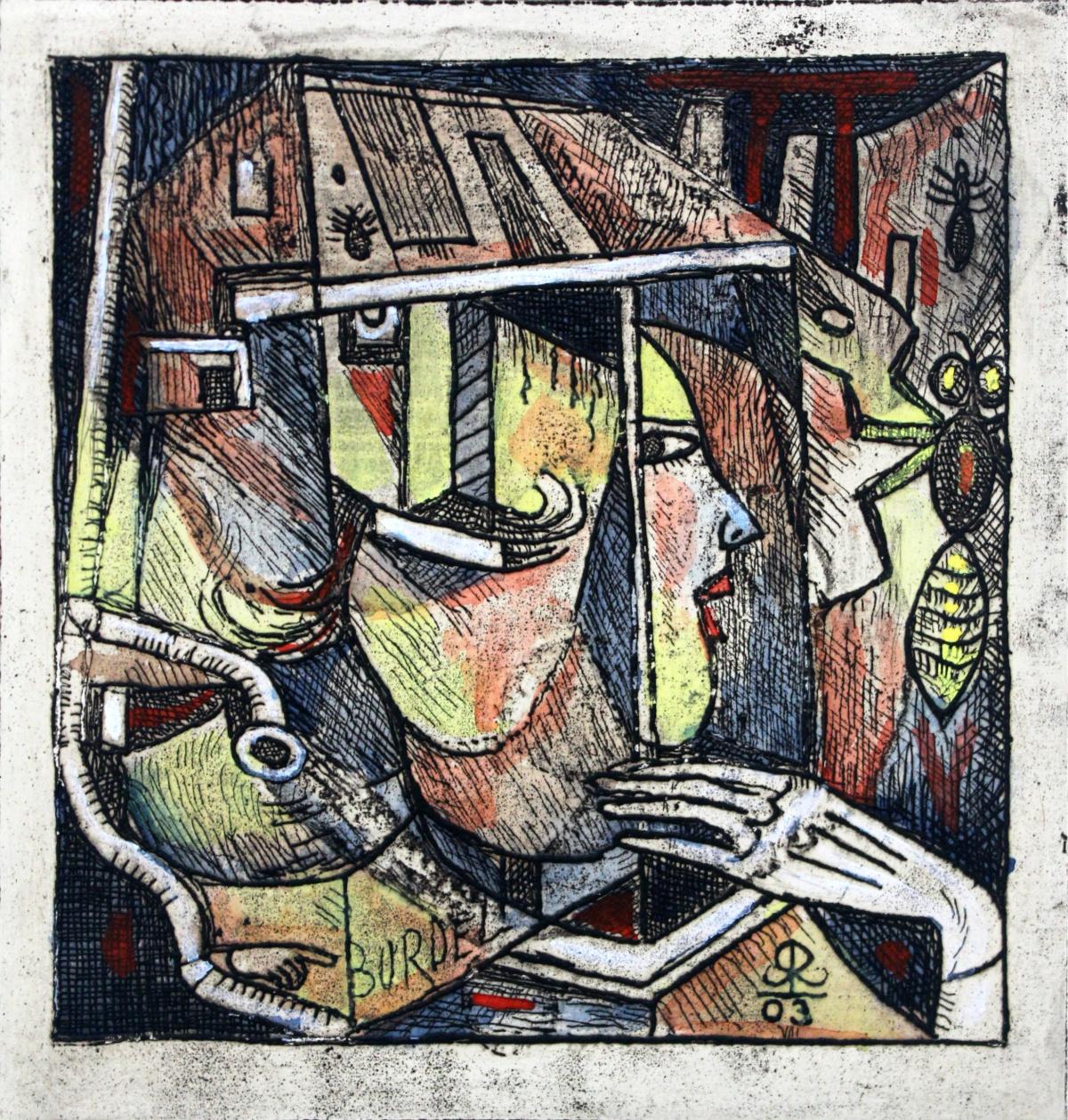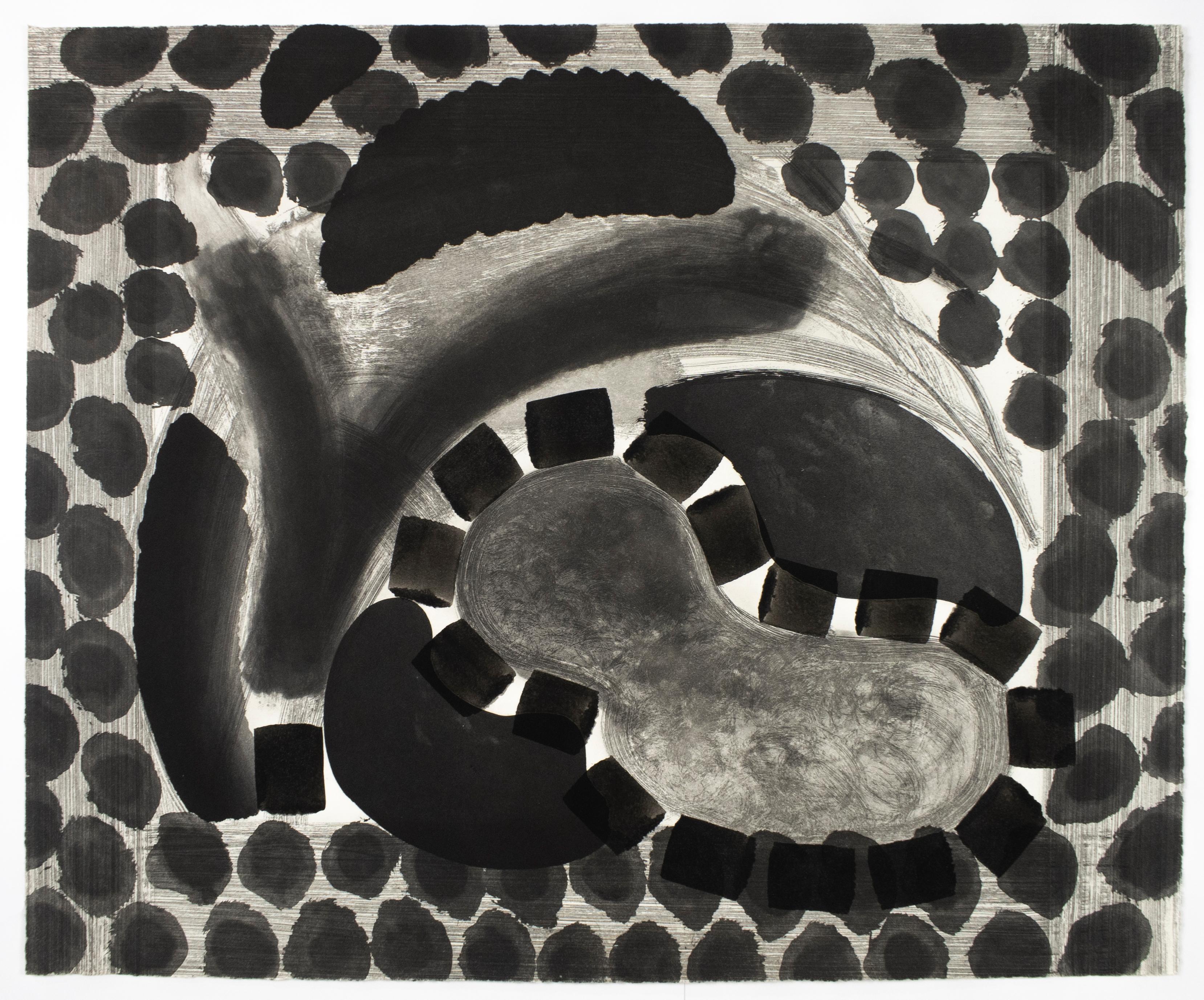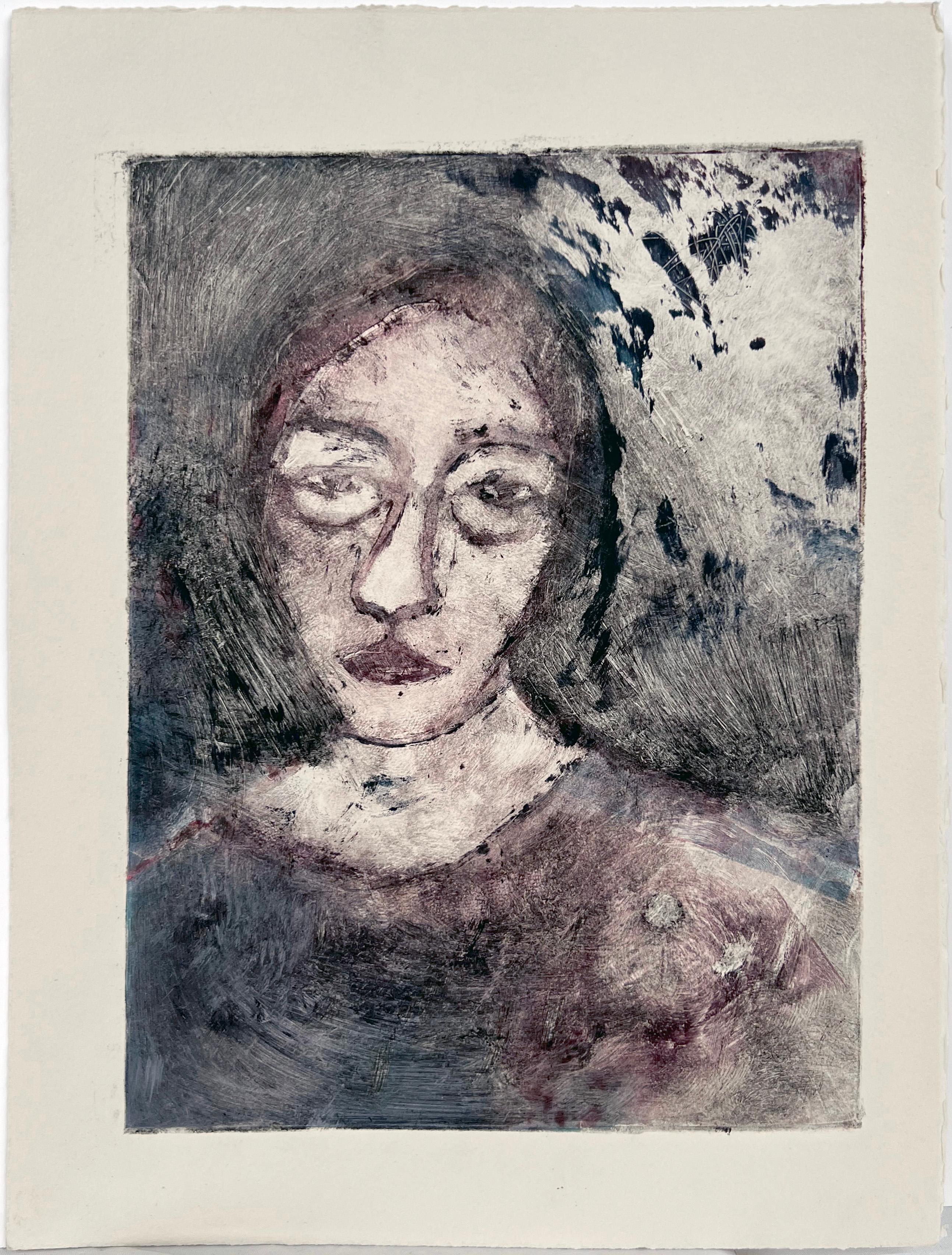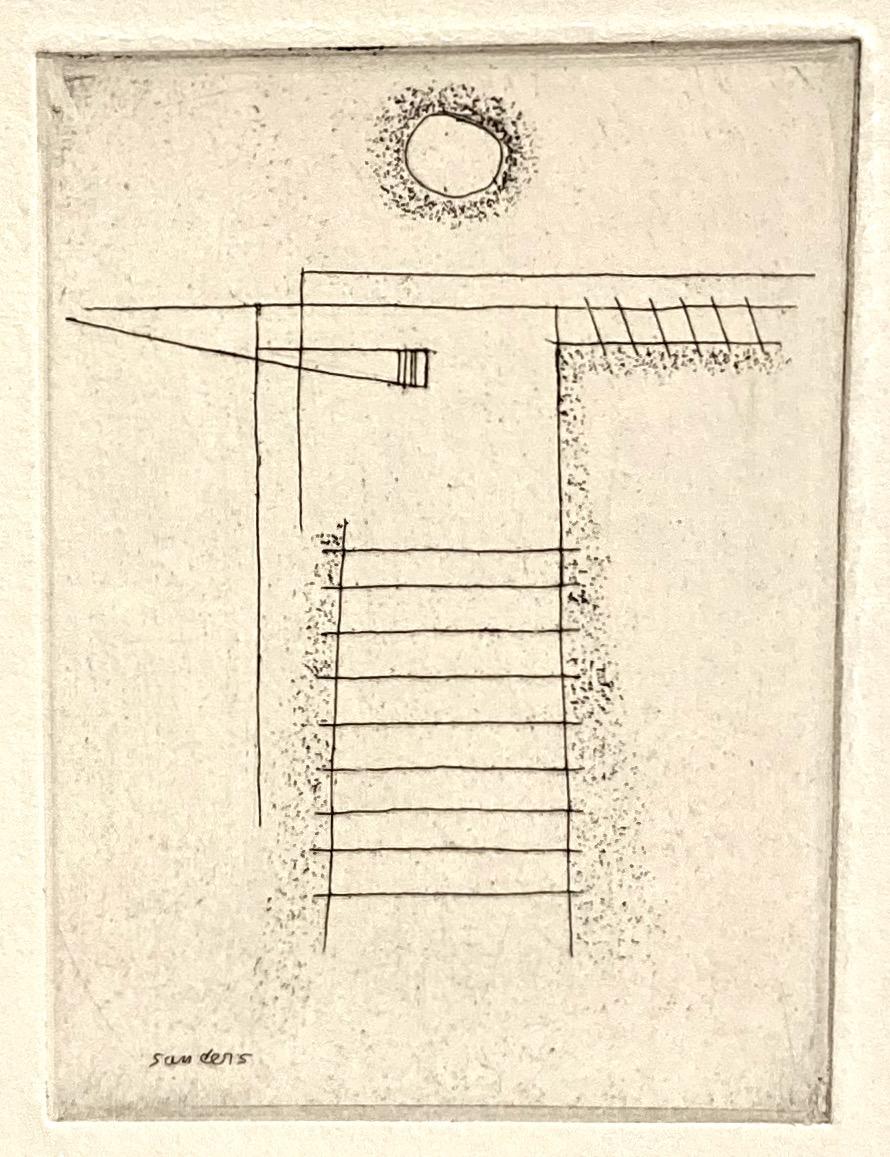Items Similar to Alice in Wonderland
Want more images or videos?
Request additional images or videos from the seller
1 of 10
Knox MartinAlice in Wonderlandca. 1972
ca. 1972
About the Item
Knox Martin
Alice in Wonderland, ca. 1972
Etching with hand-coloring in watercolor on wove paper
Hand signed and annotated "AP" on lower front (a unique variant)
Frame included (held in original vintage frame)
The charming, whimsical etching by renowned contemporary artist Knox Martin is an AP aside from the regular edition. It depicts Alice and various cast of characters from the story "Alice in Wonderland." It has hand coloring and is a unique variant.
A delightful work of art for children and adults alike - and a lovely gift.
Measurements:
Artwork:
20 x 22 inches
Frame:
23 x 23.5 inches
About Knox Martin:
A colleague of Willem De Kooning and Franz Kline, Knox Martin is an esteemed New York School painter. Embracing pattern, geometric structure, and organic and figurative references, his painting engages with major Post-war trends, including Abstract Expressionism, Color Field Painting, and Pop Art, without adhering to any singular artistic movement. His large-scale paintings of the 1960s employ a collage aesthetic, combining geometric forms with fields of stripes and polka dots in a bold palette of black and white, vibrant green, red, blue, and yellow. Beginning in the 1970s, the female nude, a favorite subject of De Kooning’s, became a key theme in Martin’s painting, where it is playfully fragmented and rearranged. The female form becomes a vehicle for abstraction and a reference to art historical lineages and the creative process of art making. Martin’s series of women paintings culminated in two major public commissions, Venus (1970), a twelve story mural at 19th Street and the West Side Highway, and Woman with Bicycle (1979) at West Houston and MacDougal Street (covered 2002).
-Courtesy of Hollis Taggart
- Creator:Knox Martin (1923, American)
- Creation Year:ca. 1972
- Dimensions:Height: 23 in (58.42 cm)Width: 23.5 in (59.69 cm)
- Medium:
- Movement & Style:
- Period:
- Condition:In very good condition; not examined outside of original vintage frame.
- Gallery Location:New York, NY
- Reference Number:1stDibs: LU1745213339172
About the Seller
5.0
Platinum Seller
These expertly vetted sellers are 1stDibs' most experienced sellers and are rated highest by our customers.
Established in 2007
1stDibs seller since 2022
289 sales on 1stDibs
Typical response time: 1 hour
- ShippingRetrieving quote...Ships From: New York, NY
- Return PolicyA return for this item may be initiated within 1 day of delivery.
More From This SellerView All
- Your Day in Court, from the portfolio Wisconsin GraphicsBy Warrington ColescottLocated in New York, NYWarrington Colescott Your Day in Court, from the portfolio Wisconsin Graphics, 1971 Drypoint, etching, aquatint, woodcut, & soft-ground etching, w roulette, vibrograver, letterpress ...Category
1970s Modern Figurative Prints
MaterialsDrypoint, Etching, Aquatint, Woodcut
- Beautiful Girl IIBy Tracey EminLocated in New York, NYTracey Emin Beautiful Girl II, 2011 Etching, with chine-collé on 300 GSM Somerset paper, with full margins Signed and numbered 52/100 on the front in graphite pencil; also titled by ...Category
2010s Pop Art Abstract Prints
MaterialsEtching
- American Dream (EAT / DIE / HUG / ERR) (Sheehan 136) UNIQUE Proof Love Food LifeBy Robert IndianaLocated in New York, NYRobert Indiana American Dream (EAT / DIE / HUG / ERR) (Sheehan, 136), 1986 Hard and soft-ground etching, aquatint, drypoint and stencil on white Arches paper 37 inches × 21 inches ...Category
1980s Pop Art Abstract Prints
MaterialsMixed Media, Drypoint, Etching, Aquatint, Stencil
- Historic invitation poster for 1970 ACE Gallery exhibition Minimalist light artBy Dan FlavinLocated in New York, NYDan Flavin Rare invitation poster for 1970 ACE Gallery exhibition, 1970 Letterpress and stencil on colored paper Not signed Frame included Floated in the original ACE gallery vintage wood frame. Measurements: Framed: 17.75" x 17.75" x 1.6 inches Poster: 16 inches x 16 inches Extremely uncommon letterpress and stencil poster designed by Dan Flavin on the occasion of his 1970 exhibition “Two Cornered Installations in Colored Fluorescent Light from Dan Flavin” at the legendary Ace Gallery in Los Angeles. The poster, like most exhibition invitations of that era (including those from the Leo Castelli gallery in New York) was undated, as these works were so much of the moment. This work was acquired directly from the collection of the ACE Gallery. Other than the present work, we've never seen another example of this collectors item anywhere in the world, on or off the market (If anyone is aware of others, we'd love to see!) More about the legendary ACE gallery, and the sale of some of its art collection from the bankruptcy estate, from where the present work was acquired: ACE Gallery founder Douglas Chrismas opened his own frame shop and gallery in Vancouver at the age of 17. His gallery became known as a venue where Vancouver artists could show alongside major New Yorkers, and get the feeling of belonging to a bigger scene. In the 60s and early 70s he brought artists such as Robert Rauschenberg, Carl Andre, Sol LeWitt, Bruce Nauman, and Donald Judd to Vancouver, Canada. The gallery expanded to Los Angeles in 1967 at the former Virginia Dwan Gallery space in Westwood, and then further expanded to New York in 1994. The galleries were noted for doing museum-level exhibitions by up and coming and internationally renowned artists. While in New York the gallery’s presence was amplified by doing exhibitions in conjunction with cultural institutions such as the Guggenheim Museum and the Cartier Foundation (Paris). Under Chrismas' directorship, ACE Gallery has had either offices or galleries in art centers outside of the United States, such as Mexico City, Paris, Berlin. and Beijing. In 1972, Chrismas mounted Robert Irwin’s installation Room Angle Light Volume at the first ACE/Venice, which opened at 72 Market Street in 1971. In 1977, ACE mounted exhibitions of work by Frank Stella and Robert Motherwell, along with Michael Heizer’s Displaced/Replaced Mass. Installed at ACE/Venice, the Heizer piece required that huge chunks be gouged out of the gallery floor to create recessed areas able to accommodate boulders. In April 2016, ACE Gallery emerged from a three-year bankruptcy proceeding under the leadership of Sam S. Leslie. In May 2016, founder Douglas Chrismas was terminated from all roles at the gallery. In July 2021, Douglas Chrismas was arrested by the FBI and charged with embezzlement. In May 2022, Douglas Chrismas was ordered to repay 14.2 million in ACE art sale profits, which were diverted to personal accounts. Chrismas is awaiting criminal trial in January, 2023. He faces up to 15 years in prison if convicted. Controversies In a 1983 lawsuit in Los Angeles federal court, Rauschenberg sought $500,000 from Chrismas' Flow ACE Gallery; the artist won a $140,000 judgment in the suit in 1984. Eventually the two reconciled their differences and in 1997 Robert Rauschenberg insisted that ACE Gallery New York (in conjunction with the Guggenheim Museum) host his Retrospective. In 1986, Chrismas pleaded no contest after Canadian real estate developer C. Frederick Stimpson alleged that he had improperly sold work belonging to the collector, among them pieces by Andy Warhol and Rauschenberg. Under the terms of the settlement, Chrismas agreed to pay Stimpson $650,000 over a period of five years. He continues to work with the Stimpson family in handling their art interests. In 1989, ACE Gallery wanted to borrow a work by Judd along with Carl Andre's 1968 Fall, both owned by Count Giuseppe Panza, for an exhibition devoted to minimal art called The Innovators Entering into the Sculpture. Rather than shipping the two large scale works from Italy, Panza authorized ACE Gallery to refabricate the pieces in Los Angeles. In Panza's collection archives, there is a series of signed certificates signed by Judd that granted Panza broad authority over the works by Judd in his collection. These certificates "authorized Panza and followers to reconstruct work for a variety of reasons," as long as instructions and documentation provided by Judd were followed and either he or his estate was notified. This even included the right to make "temporary exhibition copies, as long as the temporary copy was destroyed after the exhibition; and the right to recreate the work to save expense and difficulty in transportation as long as the original was then destroyed." Miwon Kwon, in her account of site specificity: "One Place After Another," presents the account of ACE Gallery recreating artworks by Donald Judd and Carl Andre without the artist's permission. Andre and Judd both publicly denounced these recreations as "a gross falsification" and a "forgery," in letters to Art in America, however, the fabrication of the pieces were permitted by Panza Collection in Italy, the owner of the works. Despite the confusion surrounding the Panza refabrications, both Carl Andre and Donald Judd maintained a professional relationship with Douglas Chrismas and ACE Gallery. Andre showcased works at ACE Gallery in 1997, 2002, 2007, 2011 and present day. In 2007, Carl Andre's show entitled "Zinc" was exhibited at ACE Gallery in Beverly Hills. Donald Judd paid a visit to The Innovators Entering into the Sculpture exhibition at ACE Gallery and agreed to keep his sculpture in the exhibition. After the exhibition was over, Chrismas planned to sell the metal used for the re-fabrication of Judd's work for scrap metal but Judd wanted to own the re-fabrication for himself. ACE Gallery then sold the re-fabrication of Donald Judd's work to Donald Judd. After having consigned more than $4 million worth of art to ACE Gallery to sell in 1997 and 1998, the sculptor Jannis Kounellis filed a lawsuit in Los Angeles Superior Court in 2006, accusing Chrismas of keeping most of the profits of artworks and refusing to return the pieces that did not sell. According to the lawsuit, the primary agreement between Kounellis and Chrismas was oral. Chrismas returned all of Kouenllis' artwork, and did a full accounting of the proceeds from Kounellis' work—minus the expense of exhibiting it. The matter was resolved between the two of them and ACE Gallery still sells and exhibits Kounellis' work today. By 2006, Chrismas had filed for Chapter 11 bankruptcy protection at least six times since 1982, barring most of his creditors from collecting the money immediately owed to them. Chrismas filed for Chapter 11 bankruptcy to protect the gallery's extensive real estate holdings from the problematic landlord. The landlord of the Wilshire Boulevard space, Wilshire Dunsmuir Company, claimed that ACE owed back rent and penalties however, the claim was disputed by Douglas Chrismas. In court papers, Chrismas Fine Art claimed that it would cure "the pre-petition" debt by Feb. 1, 2000, and was asking the court to protect its right to remain in the property. A declaration filed by Douglas Chrismas characterized this leasehold as the business' primary asset. -Courtesy Wikipedia About Dan Flavin Dan Flavin (1933–1996) was a pioneer of Minimal Art. He rose to fame in the 1960s with his work with industrially manufactured fluorescent tubes, inventing a new art form and securing his place in art history. The exhibition at the Kunstmuseum Basel focuses on his works that are dedicated to other artists or make reference to certain events. Back in 1963 Dan Flavin mounted a single, industrial fluorescent light tube at a 45-degree angle to the wall of his studio declaring it art; the act was radical, and it still is. Indeed, it was owing to this action that standard commercial products would be introduced into art: The nascent Minimal Art of the era emphasised seriality, reduction and matter-of-factness. Somewhat ironically, while the autodidact Flavin never himself sought membership to this movement in art, he would, and quite literally, go on to become one of its most illustrious exponents. Flavin began work with fluorescent light tubes from the early 1960s on; arranged in so-called ‘situations’, he would then further develop them into series and large-scale installations. The colours and dimensions of the materials he used were prescribed by industrial production. Flooded in light, viewers themselves become part of the works: The space, along with the objects within it, are set in relation to each other and thus become immersive experiences of art triggering sensual, almost spiritual experiences. Flavin liberated color from the two-dimensionality of painting. The prevalent perception of his light works has, to date, largely centred on their minimalist, industrial aspect, and thus on the inherent simplicity of their beauty. The exhibition at Kunstmuseum Basel, by contrast, places emphasis on looking at Flavin’s oeuvre in a less familiar setting: His pieces, although initially without clearly recognisable signature, frequently make reference in their titles to concrete events, such as wartime atrocities or police violence, or are dedicated to other artists—as in the work untitled (in memory of Urs Graf...Category
1970s Minimalist Figurative Prints
MaterialsEtching, Stencil
- ERR (Sheehan 29)By Robert IndianaLocated in New York, NYRobert Indiana ERR (Sheehan 29), 1963 Photoengraving and Etching on off-white Rives BFK paper Hand signed, dated and annotated on lower front with artist's blind stamp from Coenties ...Category
1960s Pop Art Abstract Prints
MaterialsEngraving, Etching
- Torero (de-accessioned from the Denver Art Museum)By Stanley William HayterLocated in New York, NYStanley William Hayter Torero (de-accessioned from the Denver Art Museum), 1929-1933 Engraving on laid paper, third (final) state, on heavy BFK Rives off-white wove paper Signed, tit...Category
1930s Abstract Expressionist Abstract Prints
MaterialsEngraving, Etching
You May Also Like
- Spanish fly - XXI Century Abstract Etching Print with Watercolor, FigurativeBy Leszek RózgaLocated in Warsaw, PLLESZEK RÓZGA (1924-2015). He studied painting at Maria Skarbek-Kruszewska private atelier in 1945-46. In 1948, he began studies at the art school in Łódź (later: Academy of Fine Art...Category
Early 2000s Contemporary Abstract Prints
MaterialsPaper, Watercolor, Etching
- Little town - XX Century Figurative Etching Print with Watercolor, ColorfulBy Leszek RózgaLocated in Warsaw, PLLESZEK RÓZGA (1924-2015). He studied painting at Maria Skarbek-Kruszewska private atelier in 1945-46. In 1948, he began studies at the art school in Łódź (later: Academy of Fine Art...Category
Early 2000s Contemporary Abstract Prints
MaterialsPaper, Watercolor, Etching
- David's Pool at Night (David Hockney's Pool) black white abstract Howard HodgkinBy Howard HodgkinLocated in New York, NYLarge scale black and white etching depicting an abstracted pool, at David Hockney’s home in Los Angeles. This hand painted Howard Hodgkin work is i...Category
1980s Abstract Prints
MaterialsWatercolor, Etching, Aquatint
- After Lunch Howard Hodgkin: Abstract black white painting, dots lines textureBy Howard HodgkinLocated in New York, NYAbstract black and white hand painted print of interior scene with dots, lines, shadow and painted brushstroke texture. Ideal for display in minimalist, modern and contemporary space...Category
Late 20th Century Abstract Figurative Prints
MaterialsPaint, Gouache, Etching
- Abstract portrait of a Woman Finely Detailed Collotype on paperLocated in Soquel, CAAbstract portrait of a Woman Finely Detailed Collotype on paper Finely detailed abstract collotype of a woman by Heather Speck a San Francisco. Californi...Category
1990s Abstract Expressionist Abstract Prints
MaterialsPaper, Oil, Ink, Gouache, Etching
- Bernard Sanders, (Abstraction with Sun)Located in New York, NYBernard Sanders (1906-1967) was a master of minimalist prints. In several I've posted the subject is really atmosphere and tension. This could be r...Category
Early 20th Century American Modern Figurative Prints
MaterialsEtching
Recently Viewed
View AllMore Ways To Browse
Bird Four Poster
St Christopher Painting
Engraving Egypt
Academic 19th Century Painting Nude
How To Become A Seller On 1stdibs
Emiliano Zapata
Marquis De Sade Dali
Marc Brown Illustration
Foot Stall
Chanel Castle
Peter Max Heart Series
Erotic Scene 1940
Original Stardust
Russian Icon Crucifixion
Evian Vintage
Vintage Louvre Doors
Vintage Poster World Fair 1915
Vintage Potting Shed Sign




